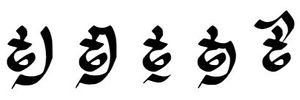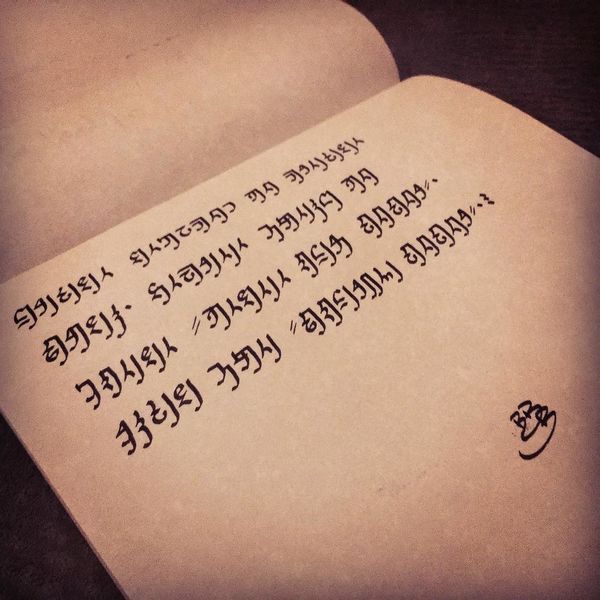Lortho: Difference between revisions
m (→Example texts) |
m (→Writing System) |
||
| Line 67: | Line 67: | ||
The Lortho alphabet is an [[wikipedia:abugida|abugida]]. The writing system behaves in a similar manner to | The Lortho alphabet is an [[wikipedia:abugida|abugida]]. The writing system behaves in a similar manner to Devanagari; however, there are no conjunct consonants. Ligatures are only formed by the combination of consonants and vowels. This writing system was inspired by [[w:Devanagari|Devanagari]], [[w:Tibetan_alphabet|Tibetan]], and [[w:Tengwar|Tengwar]]. | ||
{| style="border-style:solid; border-width:1px; border-color:#a9a9a9;" | {| style="border-style:solid; border-width:1px; border-color:#a9a9a9;" | ||
Revision as of 03:25, 23 July 2017
Introduction
Lortho (IPA:[ˈloɾ·tʰo]) is an a priori constructed language created by Brian Bourque in the beginning of 2003. It originally started as a prop for a strategy board game where only the script was created for aesthetics. Fast forward about 13 years and it has now evolved into a fusional-agglutinating language. The verbs are conjugated with suffixes and nouns are declined to denote case.
Inspiration
A friend was creating a board game similar to Risk; however, instead of taking place on Earth, this new game was to take place on an inter-planetary scale. The game creator wanted to develop an alien theme and requested a fictional script. The name of the race on this game is "Lortho" and thus the seed was planted. The author was unable to work on this piece for quite sometime until he joined the CONLANG mailing list and observed both seasoned and novice conlangers discussing all aspects of linguistics. Since then he decided to move forward and bring Lortho into fruition.
Another inspirational source is Brian's daughter. Through her development of learning how to make speech sounds leading to coherent speech, Brian found certain "words" to use in Lortho which he used to develop its phonology.
Setting
| UNDER DEVELOPMENT |
|---|
The people who speak Lortho live on a planetary system which orbits a binary star.
Phonology
Orthography
Writing System
The Lortho alphabet is an abugida. The writing system behaves in a similar manner to Devanagari; however, there are no conjunct consonants. Ligatures are only formed by the combination of consonants and vowels. This writing system was inspired by Devanagari, Tibetan, and Tengwar.

|
| Lortho Alphabet |
Vowels
The vowels are written similarly to the vowels seen in Devanagari.

|
| Lortho Vowels |
Sample Text
Below is a sample text with the conscript described above.

|
| [konpʰɑɾin loɾtʰomɛ] I speak Lortho |
Consonant Inventory
There are 21 consonants in Lortho and all are strictly pronounced the same regardless of placement.
| Bilabial | Labiodental | Alveolar | Postalveolar | Velar | Glottal | |||||||
|---|---|---|---|---|---|---|---|---|---|---|---|---|
| Plosive | p pʰ | b | t tʰ | d dʰ | k kʰ | ʔ | ||||||
| Nasal | m mː | n nː | ||||||||||
| Tap or Flap | ɾ | |||||||||||
| Fricative | f | s | ʃ | h | ||||||||
| Lateral Approximant | l lʰ | |||||||||||
Vowels and Diphthongs
Vowel Inventory
There are five vowels in Lortho and are strictly pronounced regardless of placement:
| Front | Central | Back | |
|---|---|---|---|
| Close | i | u | |
| Close-mid | o | ||
| Open-mid | ɛ | ||
| Mid | ɑ |
Diphthongs
The following diphthongs exist in Lortho:
- [aɪ], [aʊ], [eɪ], [ɔɪ]
Syllable Structure
The syllable structure is (C)V(V)(C).
Prosody
Stress
There are a few rules that govern stress (with exceptions):
- Stress is always on the second to the last syllable of the root or infinitive except:
- -n verbs will always receive stress on the last syllable of the infinitive or root.
- If the word is only two syllables long, then the stress is on the first syllable.
- Stress is never given to prefixes or suffixes.
Intonation
Lortho is still in development and has not enough information to explain the rules of intonation.
Phonotactics
Consonant Clusters
Consonant cluster onsets and codas are not allowed; however, clusters are allowed in certain adjacent syllables (e.g. CVC.CVC).
Morphophonology
Still in development.
Morphology
Nouns
Introduction
Nouns in Lortho have three distinct features:
- They are one of three genders: masculine, feminine, or neuter
- All nouns are declined to denote case
- All nouns end in a vowel
| Masculine | Feminine | Neuter |
|---|---|---|
| -i | -u | -ɑ |
Grammatical Case
Lortho has ten cases. The vowels in parentheses are added if the word ends in a consonant.
| Case | Modifier | Example | Translation |
|---|---|---|---|
| Nominative | - | kɑnsɑptʰɑ | woods, forest |
| Accusative | -(i)mɛ | kɑnsɑptʰɑmɛ | forest (direct obj.) |
| Dative | -(i)mɛlɑ | kɑnsɑptʰɑmɛlɑ | forest (indirect obj.) |
| Genitive | -(i)nɑlo | kɑnsɑptʰɑnɑlo | of the forest |
| Sublative | -ɪnɑ/-ɛnɑ | kɑnsɑptʰaɪnɑ | in/into the forest |
| Ablative | -(ɛ)nɑt | kɑnsɑptʰɑnɑt | out of/from the forest |
| Allative | -(ɛ)dɑn | kɑnsɑptʰɑdɑn | to/towards the forest |
| Prolative | -(ɛ)dɑnɑɾ | kɑnsɑptʰɑdɑnɑɾ | through/via/by way of the forest |
| Instructive | -(i)lɛn | kɑnsɑptʰɑlɛn | using the forest |
| Vocative | fɑ- | still in development | |
Personal Possessive Prefix
The personal possessive is formed using a prefix which is gender and number specific.
| Person | Singular | Plural | ||||
|---|---|---|---|---|---|---|
| 1st person | ni- | nu- | - | nimɑ- | numɑ- | - |
| 2nd person | lin- | lun- | - | nɑni- | nɑnu- | - |
| 3rd person | li- | lu- | lɑ- | limi- | limu- | limɑ- |
Pluralization
Each noun is pluralized by gender and in some cases, the plural ending is changed for ease of pronunciation.
- Feminine nouns (-u): simply add the plural ending -nɛ.
- Example: [kɑnsɑpʰu] (n. fem) tree; pl [kɑnsɑpʰunɛ]
- Masculine nouns (-i): subtract the -i and add the plural ending -ɛni except :
- Masculine noun roots that end in -n, the plural ending will be changed to -ɛmi.
- Examples:
- [olɑkʰi] (n. masc) boat; pl [olɑkʰɛni]
- [pʰoɾɛnːi] (n. masc) peak, summit; pl [pʰoɾɛnːɛmi]
- Neuter nouns (-ɑ): simply add the plural ending -nɛ (many neuter nouns are collective nouns such as [hɑmːunɑ] weather)
- Example: [hɑdikʰɑ] (n. neut) land, country; pl [hɑdikʰɑnɛ]
Verbs
Introduction
Verbs are conjugated in gender and in number which are governed by the subject (written or implied).
Conjugation
There are three main verbs in Lortho: -o verbs, -t verbs, and -n verbs. The conjugation table below shows a preview of how the regular verbs conjugate in each type. Conjugation in other tenses includes more fusional aspects.
| Present Tense | ||||||||||||||||||
|---|---|---|---|---|---|---|---|---|---|---|---|---|---|---|---|---|---|---|
| -o verbs [konpʰɑɾo] to speak verbal root: konpʰɑr |
-t verbs [pʰɾɑmit] to push verbal root: pʰɾɑmid |
-n verbs [ʃaɪlɑn] to sit verbal root: ʃaɪlɑn | ||||||||||||||||
| Singular | Plural | Singular | Plural | Singular | Plural | |||||||||||||
| masc | fem | neut | masc | fem | neut | masc | fem | neut | masc | fem | neut | masc | fem | neut | masc | fem | neut | |
| 1st pers | konpʰɑɾin | un | - | -inɑn | -unɑn | - | pʰɾɑmidin | -dun | - | -dinɑn | -dunɑn | - | ʃaɪlanin | -un | - | -inɑn | -unɑn | - |
| 2nd pers | konpʰɑɾɑnːi | -ɑnːu | - | -ɑmin | -ɑmun | - | pʰɾɑmidɑnːi | -dɑnːu | - | -dɑmin | -dɑmun | - | ʃaɪlanɑnːi | -ɑnːu | - | -ɑmin | -ɑmun | - |
| 3rd pers | konpʰɑɾi | -u | -ɑ | -imi | -imu | -imɑ | pʰɾɑmidi | -du | -dɑ | -dimi | -dimu | -dimɑ | ʃaɪlani | -u | -ɑ | -imi | -imu | -imɑ |
Adjectives
Adjectives behave a little differently from other words in that they:
- must be placed in front of the noun which they modify
- must agree in gender, but not in number or grammatical case
Syntax
Morphosyntactic Alignment
The morphosyntactic alignment of Lortho is Nominative - Accusative.
Word Order
Verb-Subject-Object (VSO). Lortho contains a lot of information in the verb and the noun or noun phrase. The verb is conjugated by person and gender and thus pronouns are largely unnecessary except for emphasis or clarification. The nouns are altered to denote case, removing almost entirely the need for prepositions.
Example texts

|
| The people are known as people of the lanterns and they lived in that forest. |

|
| I ran out of the forest and climbed the mountain. I was speaking to the dragon and said, "I want to walk through here." The dragon replied, "You will not walk through here." Source: Brian's Instagram post |
Other resources
Word Agreement
The three following rules govern agreement between words:
- Verbs must agree in gender and number with the subject
- Nouns are not pluralized when counted
- Adjectives must agree with the noun in gender, but not in grammatical case or number